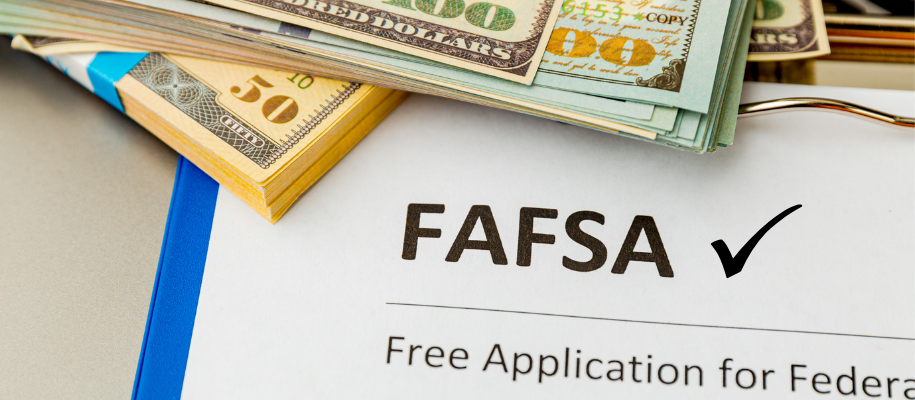Imagine passing up free money for college. Money with no strings attached. That would be crazy, right? Yet every year, hundreds of thousands of students who are eligible for federal student aid never receive it—because they don’t even apply for it. According to the New York Times, nearly 1.7 million high school seniors neglected to fill out the Free Application for Federal Student Aid (aka the FAFSA) during the 2020–2021 school year. Of those students, just under half would have likely qualified for a federal Pell Grant for low-income students. For many students, that unclaimed money may have made the difference between just a high school diploma and a college education. Sure, filing the FAFSA can seem like an intimidating process. Some families decide it’s not worth the hassle; others think their income is too high to qualify. Don’t make their mistake.
What is the FAFSA all about?
The federal government awards over $240 billion in aid to undergraduate and graduate students in the form of grants, loans, and work-study. Nearly $150 billion is grant aid, including federal, state, and institutional awards—and a portion of that money could be yours. Though the recent FAFSA Simplification Act has caused delays and stress for families, the form is now shorter and requires fewer inputs. This is part of an effort to make the FAFSA easier to fill out and accessible to more students. And the FAFSA considers several other factors along with income, so even if you think your family makes “too much money” to qualify for aid, you should always apply. After all, the form is free, and you really don’t have anything to lose. If you find the FAFSA daunting (as so many students and families do), don’t be afraid to ask for help. “Don’t go it alone,” advises Ajamu Clarke, Program Manager for DC public schools at the DC College Access Program, which helps low-income students apply to college. You might find your own local college access program, or you can ask your high school or college counselor for help. You can also call the admission offices of the colleges and universities you’re applying to, or perhaps even the local community college—whether you're applying there or not. They will gladly help!
If you don't qualify for grants
Even if you aren’t eligible for a federal grant, you might still be awarded work-study or federal loans, which often offer lower rates and more flexible repayment options compared to private loans. For a rough idea of what you might qualify for, try using the Federal Student Aid Estimator on the FAFSA website. This tool gives a quick estimate based on just a few data points, such as family income and number of family members. Just keep in mind this is an estimate only; your actual FAFSA results take a lot more into account and will likely be different.
Important changes to FAFSA filing dates
One big change to the FAFSA has been the new filing window. After numerous delays and trying to remedy last year's issues, the 2025–2026 FAFSA is set to open on December 1, a few months later than the historical date of October 1. This delay will allow the Department of Education to perform beta testing and resolve any system issues that students and institutions may experience. Once the form is available, don’t wait too long to fill it out! Although you have until June 30 to submit the form for that academic year, it's always best to file it as close to each year's launch date as possible. The earlier you submit the FAFSA, the better your chances of getting a generous aid package since many states and colleges award aid on a first-come, first-served basis.
Related: How to Get Financial Aid for College: The Ultimate Guide
How long does the FAFSA take?
The FAFSA site estimates the form takes less than an hour to complete, and most people can probably finish in half that time, especially with the recent simplifications. The 2024 updates have streamlined the online process, with a reduction in the number of questions and the requirement to import tax information, making it quicker than before. However, you’ll still want to have your paperwork ready, particularly for the financial information sections. Some sections should be relatively quick since you won’t need bank statements or other financial records, but the financial sections may take a little more time. Our best timesaving advice: Collect all your financial documents before you begin so you and your parents won’t have to stop and rummage through files!
What do you need to file the FAFSA?
Here’s what you’ll need to gather before filing the FAFSA. Heads up: You need this information for both the student and parents/guardians if you're considered a dependent.
- Tax returns (1040, etc.), W-2s, and other records of income earned from two years ago (you can now import this information from the IRS; see section below)
- Current statements from bank accounts, including checking and savings
- Current statements for any investments such as stocks or mutual funds, if applicable
- Records of untaxed income, if applicable (here's what counts as taxed and untaxed income, according to the IRS)
- Records of assets, from farm properties to investment real estate, if applicable
- Social Security number (or alien registration number if a non-citizen)
- Driver's license, if applicable
- FSA ID number (more on that below!)
New tax information process
The FAFSA will now automatically pull your family’s federal tax information using a tool integrated into the IRS system. This reduces the need to manually input data from tax returns, minimizing errors and making the process faster for families.
Ready to begin the FAFSA?
Head over to the official FAFSA website: studentaid.gov. Don’t fall for websites that charge a fee to submit the form; as the name clearly states, the Free Application for Federal Student Aid is entirely free, so only apply on the FAFSA’s official website! Any other site that charges you to file is not legitimate. You can also complete a physical FAFSA and mail it in, but online applications are processed quicker than paper ones—one to three days vs. seven to 10—so you may miss out on valuable first-come, first-served aid if you take this route.
Your first steps
First, you’ll need to create a Federal Student Aid ID (FSA ID), which is used to access financial aid information through college and beyond. Parents will also need their own FSA IDs to complete the form. It’s crucial not to mix up parent and student IDs, as this can delay the process. If you’re a returning user, simply log in with your existing FSA ID. That way, some of your information (like basic demographics) will be filled in automatically.
As soon as you create your ID, write it down and keep it in a place you will not lose it. Your parents should do the same. Forgetting this ID is a leading reason why students delay or never end up completing the form, according to LD Ross, Jr., Director of Programs at DC College Access. While it’s possible to retrieve a lost FSA ID, it can be time-consuming, so it’s best to store it safely right from the start.
Save keys and intro information
Next, create a save key—a short-term password that lets you pause and return to the form later. You and your parents can share the save key so you can enter the first few sections and they can continue with the trickier financial questions. You’ll then be taken to the Introduction page, which offers links to some basic questions you might have before you begin: What documents do I need? (There’s a list.) Can I take a break and finish later? (Yes, you can save the form for up to 45 days. However, it’s still best to file the FAFSA as soon as possible, as we explained before.)
Ensuring accuracy
One last thing before we go step by step through each section: Make sure your FAFSA is totally accurate. That means carefully inputting information and proofreading your work before hitting submit—especially since errors can delay processing and potentially cost you FAFSA dollars. But more importantly, do not, under any circumstances, under-report or omit assets or income. Lying on the FAFSA is fraud, the government is very good at sniffing it out, and you will not only have to repay every federal financial aid dollar you receive, but you (and your parents) could be subject to significant fines and a prison sentence. Now, with that chilling warning out of the way, let’s take you through the FAFSA, section by section.
Related: 5 FAFSA Tips to Get the Most Financial Aid
FAFSA sections
It’s not the most beautifully designed website, but it’s clear enough, and at each step online, a “Help and Hints” box pops up at the side in case you need guidance. If you still have questions with any of the FAFSA sections or steps, ask your school’s college counselor, or call your college's financial aid office.
1. Student identity information and personal circumstances
This is pretty basic stuff like contact information, marital status, college or career school plans, unusual circumstances, family size, student demographics, race and ethnicity, state of legal residence, parent education status, and the name of your high school. (If your parents don’t have college degrees, you may be eligible for state grants specifically for students who are the first in their family to attend college.) There used to be a question in this section that asked if you were interested in federal work-study, but it has been removed with the recent FAFSA updates. If you qualify for this option, the college(s) you choose will likely offer it to you as part of your financial aid package. You can also contact the school directly to see if the program is available to you. The Selective Service question has also been removed, as you do not need to register for the military draft anymore to receive federal aid.
2. Student financial information
To be eligible for federal student aid, you need to give consent for the FAFSA to retrieve and disclose your federal tax information. This allows the form to automatically import your financial data from the IRS, simplifying the process. According to the Federal Student Aid website, "Providing consent allows you to skip nearly all of the remaining income and tax questions on the FAFSA." If you don't give consent, the FAFSA will not calculate a Student Aid Index (SAI), making you ineligible for federal aid. After you consent, the FAFSA will use your prior-prior year’s tax return (two years before the academic year for which you're applying) and other financial information to determine your eligibility for aid. You’ll also be asked about assets—both your parents’ and yours. That’s right: Any money you’ve saved from summer jobs, birthdays, or other sources will be considered. Colleges typically expect you to contribute a percentage of your savings toward tuition.
Next, you’ll choose the colleges you want to receive your FAFSA information. You can list up to 20 schools online. Don’t worry if you haven’t finalized your list—you can add or change colleges later. The order of schools doesn’t matter for federal aid, but for state aid, some states may require colleges to be listed in a specific order, such as listing a state school first. Be sure to check the Federal Student Aid website to see if your state has any such requirements. Once you've completed this section, ensure that everything is accurate and honest before signing. And then your work here is done! Your parents or guardians now need to fill out their portion of the form.
3. Student spouse tax information
If you're not married, you won't need to fill out this section. But if you are, you'll need your spouse’s income and tax information in order to qualify for federal aid. They'll just provide their consent to import their info from the IRS like you did and sign.
4. Parent information
Colleges want to know if your parents support you or if you are an independent adult. The vast majority of high school students are considered dependent for college financial aid/FAFSA purposes. However, you’re generally considered an independent student if you are:
- 24 years old by December 31 of the award year
- A graduate or professional student during the award year
- Married (or separated)
- A parent or have other dependents who currently receive more than half their support from you
- An orphan or a ward of the court
- A veteran of the US Armed Forces
In these cases, you won’t be asked about your parents’ or guardians’ demographics or finances. Otherwise, you are most likely a dependent student. If your family situation is complex (for example, you are a minor but don’t live with your parents or you don’t have access to their financial information), you can find some guidance on family dynamics on the Federal Student Aid website. And, yet again, high school counselors and college financial aid officers can be a big help in answering your questions.
To reiterate, a parent will fill this section out if you are a dependent. Aid decisions will consider your parents’ age (because older parents may need to conserve more for retirement) and how many children they support. (It's important to note that the new FAFSA formula no longer considers the number of family members attending college simultaneously, which may reduce the amount of aid families receive if they have multiple children in college.) Each of these elements affects the calculation for your Student Aid Index (previously called the Expected Family Contribution, or EFC), so answer these questions carefully. They cover parent tax filing status, tax return info, child support and federal benefits received, and parent assets. Of course, your parents will need to report their savings and investments too, including money market accounts, mutual funds, 529 college savings accounts (yours and any siblings’), and investment real estate (not your family’s primary home). Qualified retirement accounts—IRAs, 401(k), 403(b), or pension plans—aren’t counted as assets. As always, you can find guidance in the pop-up help boxes on the right side of the page. Parents will also give consent to have their information automatically retrieved from the IRS.
5. Other parent information
Here's where you fill in the information for the student's other parent, if applicable. Just fill out the basic information, provide consent to transfer federal tax info from the IRS, and press "Approve."
Related: Important FAFSA Updates for Students With Divorced or Separated Parents
6. Preparer information
This section is only for those who fill out or prepare the FAFSA for others. If you're not the parent or student involved, complete this section. Otherwise, you can skip it.
Sign and submit
You made it! After you’ve finished every section, review your information and check for any mistakes. Then add your electronic signatures with your FSA IDs and hit submit. That’s it. If your parents have another student in college, their demographic and financial information can be transferred to the next application, so they don’t have to duplicate their efforts.
Receiving your FAFSA Submission Summary
Once you submit your FAFSA, you’ll see a confirmation page. The Department of Education will then process your application, which usually takes one to three business days (or longer for a paper application). Afterward, you'll receive an email (typically within three to five days) with instructions on how to access your FAFSA Submission Summary (formerly known as the Student Aid Report, or SAR). If you didn’t provide an email address, you’ll receive the Summary by mail, but you can still access it online as long as you signed with your FSA ID. If you’re eager to check the status, you can log in to the FAFSA website at any time.
The FAFSA Submission Summary won't detail your financial aid package—that’s determined by each college. Instead, it will display your Student Aid Index (SAI), which reflects the amount the federal government calculates that your family can contribute toward your college expenses based on the financial information you provided. This is a key figure colleges use when determining your financial aid offer. If you spot any mistakes or need to add a college to your list, you can still make corrections. Guidance for making changes can be found on the FAFSA help page.
The colleges you listed on the FAFSA will immediately gain access to your information online. Each school will then decide how much financial aid it can offer you, typically based on both federal and institutional aid policies. Keep in mind that many colleges also require you to complete their own financial aid forms, such as the CSS Profile, which may have different deadlines than the FAFSA. Your financial aid award letters will usually arrive with your college acceptance letters or shortly after. These letters will outline how much aid you’re being offered, including grants, loans, and work-study. With any luck, you’ll receive strong offers from several great-fit schools.
Related: Understanding (and Maximizing) Your College Financial Aid Package
There you have it! A step-by-step guide through the FAFSA. Your last step is the hardest: Compare your financial aid offers and make your final college choice. If you have any questions, start by contacting the financial aid offices at your potential colleges or universities. You can also reach out to the FAFSA help center directly.
Want to learn even more about scholarships, grants, loans, and other ways to pay for college? Check out all the helpful articles in our Financial Aid section, including Our Best Advice to Help You Pay for a College Education.








